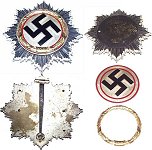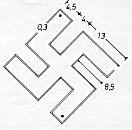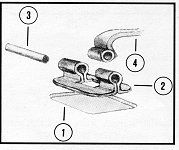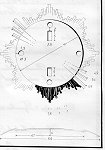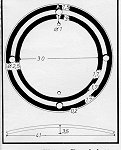
By Franηois Saez and Jacques
Calero
Description
The design of this decoration was executed by Professor R. Klein of Munich and the first examples were made by the DESCHLER firm of Munich. The first prototypes contained 10 rivets, with a system of attachment typical of the Iron Cross of 1914. To begin with, the DESCHLER firm used 6 rivets, then from from about the middle of 1942 onward, only 4.
The German Cross was composed of 5 main pieces which were assembled together, whatever the
manufacturer (not counting as pieces the pin, the hook, and the hinge).
The base piece consists of a silver star with eight rays, upon which is fixed another star with eight rays, lighter and smaller, in a dark gray color.
A silvered disk bordered with two red bands is placed above.
A swastika in black enamel bordered silver is fixed on the disk by means of two or four prongs situated on the ends of the arms.
Between the two red bands is found a gilt or silvered wreath. The year 1941 is embossed at the base of the wreath.
The wreath is fixed with four rivets. In some cases the wreath rivets maintain the whole cross (ex Zimmermann), in other case they just hold together the wreath , the circle and the black star.
The whole is held on by a number of rivets (4, 5, 6 or 10) depending on the manufacturer.
The hinge itself may be a bent piece of metal soldered in a recess at the top of the star (types marked 20, 134, DESCHLER), or more simply, soldered directly onto the star (Juncker and Godet types).
The pin is fixed to the hinge by a cross-pin. The construction of this decoration is the most complex of all the military decorations of the Third Reich.
Click on image to enlargeBroken down German Cross for maker GODET |
|
|
|
The different parts of the German Cross (not enlargeable) |
Per the LDO, the metal used in manufacture was cupal (an alloy of aluminum and copper),
tombac, and nickel silver (Neusilber), according to the different parts.
The dimensions may vary slightly between the manufacturers, but should conform to those officially stipulated by the Orders Chancery.
General Measurements |
|
| Silvered star: | 63.0mm |
| Darkened star: | 59.0mm |
| Silver disk O | 40.2mm |
| Wreath O exterior | 38.7mm |
| O interior | 1.5mm |
Swastika: |
|
| in square: | 21.5mm |
| width between two arms | 4.0mm |
| width of arms: | 4.5mm |
Thickness: |
|
| silver star: | 2.3mm |
| darkened star: | 0.6mm |
| disk: | 1.3mm |
| wreath: | 1.0mm |
| swastika: | 1.3mm |
The types described below is that made by the firm of ZIMMERMANN ( 20 ) and that of DESCHLER ( 1 ), but the statements are valid for all the models.
A) Silver star
Material: cupal / tombac weight: 16gr (20) 34gr ( 1 )
The star is convex, pierced by four holes through which the attachments for the wreath pass.
The rays forming the points of the star are polished and measure 52, 58 and 63mm.
The rest of the star is matte silver colored. The pin-back is composed of a hinge and a hook soldered on the reverse.
The broad and flat pin is fixed to the hinge by means of a cross-pin. The hinge and the hook may be soldered differently depending on the maker and type.
B) Gray-black star
Material : tombac weight: 11gr ( 20 ) 12gr ( 1 )
The gray-black star is oxidized or lacquered, the matte color may vary from dark gray to dark chestnut.
This part is in hollow stamped metal, convex, and fitted perfectly to the shape of the medallion into which it is fixed.
It is pierced with four holes for affixing the wreath, as well as two rectangular notches for the swastika. These notches only exist on the DESCHLER
type. The points of the rays of this star have a rounded profile and measure respectively 49, 54 and 59mm
long.
C) Disk
Material: tombac/nickel silver weight: 12gr ( 20 ) 14gr ( 1 )
The obverse and the reverse of the disk are matte silver. It is convex and pierced by holes to attach the swastika: 4 of 2.5mm of O and 2 of 1mm of O for the 20 type; 4 of 2.5mm and 4 of 1mm for the 1 type.
There are two grooves which permit to receive the two circles in vermilion colored enamel.
D) Laurel leaves wreath
Material : tombac weight: 4gr ( 20 ) 3gr ( 1 )
The wreath is hollow stamped metal. The four rivets are soldered on the interior.
This permits the consolidation of the first four parts of the decoration.
The ribands represented on the wreath as well as the plaque embossed 1941 are polished.

E) Swastika
Material: tombac and enamel weight: 3gr ( 20 ) 3gr ( 1 )
The swastika is in hollow stamped metal, silvered, in convex form. On the reverse are found 2 attachments ( 4 for the type by DESCHLER ). The cross is black enamel bordered in silver.
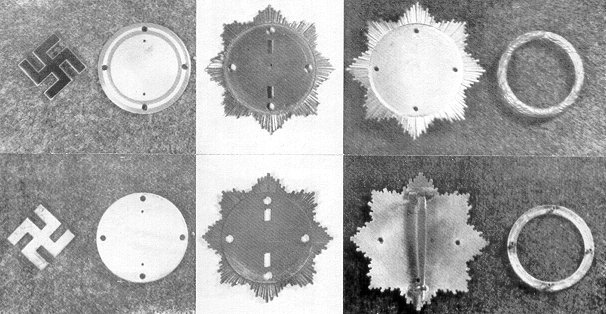


The cross is slightly convex. It was worn on the right breast side of the tunic. Granted precedence over the Spanish Cross, it was (normally we know exceptions) worn above that award if both were held.
Manufacturers
Other companies began to manufacture this decoration, without the authorization of the LDO (trade association charged with defining the exact regulations for the manufacture and quality control of awards), up until the written prohibition of the Chancery, signed by Dr Heinrich Doehle and dated August 1942. This was the case with the firm of MEYBAUER in Berlin, unauthorized by the LDO (Leistungsgemeinschaft Deutscher Ordenshersteller), whose first Crosses were marked 7 on the pin. It is possible that this firm continued to manufacture the decoration, but to this day, the authors have yet to observe an original example from this maker, marked or not.
The pin-back is not the only part where one finds differences between manufacturers. One may distinguish two types of wreaths. The first type ( DESCHLER, GODET ) is very detailed, with the edges and the laurel leaves well stamped. In the second type (ZIMMERMANN, KLEIN, STEINHAUER & LUCK ), the middle is smooth, the periphery lower and more compact. An intermediate type exists, that of the JUNCKER firm, on which the plaque 1941 and the rim bands are a little larger and the borders are detailed. The shape and the number of the rivets vary according to manufacturer.
Most of the Crosses were marked. However it is possible to find unmarked examples.
The mark may be positioned centered on the reverse of the Cross; which is the case for I and 134(in a cartouche).
The marks 1, 2, 4, and 7 are found on the pin ; 20 and 21 (in a cartouche) are marked on the underside of the pin.
Manufacturer Index and Picture Reference
The table below contains an overview of manufacturers with links to pages that contain more specific details and pictures of every maker.
Please, note that measurements can depending on whether they featured tombak or nickel outer stars. Later examples were of light weight alloy. Repairs, engravings and wear can also affect measurements and weight. We follow two types of crosses,
- Observed are pieces that were held in the hands of the authors.
- Reported: measurements given to the authors by collectors.
Click on manufacturer for more details
| Maker | Location | Mark | Rivet | Notes |
| DESCHLER & Sohn |
MUNICH |
none | 10 | Examples known are equally engraved I or not |
| none | 10 | Manufacture must be confirmed | ||
| 6 | ||||
| 1 | 4 | Heavy Model | ||
| 1 | 4 | Light Model | ||
| none | 4 | |||
| C.E. JUNCKER | BERLIN | 2 | 5 | |
| none | 5 | |||
| STEINHAUER & LάCK | LάDENSCHEID | 4 | 4 | |
| P. MEYBAUER | BERLIN | 7 | 4 | |
| ZIMMERMANN | PFORZHEIM | 20 | 4 | Heavy Model |
| PFORZHEIM | 20 | 4 | Light Model | |
| GODET | BERLIN | none | 6 | |
| BERLIN | 21 | 6 | ||
| KLEIN | HANAU | 134 | 1 | |
![]()
© Copyright Wehrmacht-Awards.com LLC |
